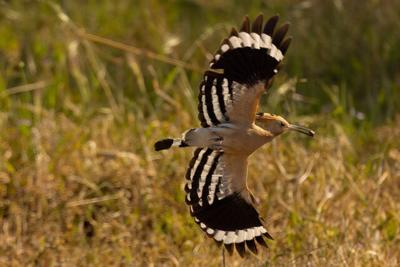“There, there on the crest of the rise,” Mary Bishop, a fellow birder staying at the amazing Paradise in Portugal lodge, calmly says, “A hoopoe!” Our driver, Frank McClintock, an excellent birding guide who has run the lodge for more than 30 years, immediately stops and the six of us birders hop out of the van. The hoopoe … the hoopoe in all its strange and wondrous glory is hopping amid the cattle feeding troughs, pulling insects from the rough ground. It lifts off and giddily glides a few feet, spreading its black and white crest as it lands and starts feeding again.
I ignore the nearby tawny pipits, spotless starlings and chattering common waxbills. I just watch and stare at this weird bird as it moves about, sometimes looking mechanical, at other times, graceful and sleek. Finally, my Holy Quail!
The Eurasian hoopoe is definitely distinctive. The bird resembles those imaginary creatures found in medieval bestiaries. So odd looking it could be an animation of an artist’s drawing created from a word description or from an ink sketch inserted in an early cartographer’s map, long before explorers of the 18th and 19th centuries included naturalists on board, deft at capturing the discovered flora and fauna in pen and ink. One old, old map of Australia had tiny squiggles around the edges representing animals of the newly-explored territory that must have mystified the zookeepers back home: Drawings that sort-of captured the shapes of kangaroos and koalas, Tasmanian tigers and dingoes.
Non-birding friends have often sent me photos or videos of this unusual-looking, puppet-like bird … from India, from Germany, from Morocco. I have tried in vain to see one, always missing out by being at the wrong place during their migration. Recently though, hoopoes have hunkered down along the southern coasts of Portugal and Spain, no longer bothering to migrate.
Hoopoes have to be one of the easiest birds in the world to identify. Nothing else looks like it. Long, black, downturned, very pointy bill, the overall body a pinky beige (almost matching the soil in the Algarve) with wings of flashy black and white and a crest that matches the wing pattern. The crest is usually only displayed on landing or during mating dances. The tail, too, is black and white.
So unique, hoopoes are the only member of the Family: Upupidae. Classification is an ongoing process and some ornithologists believe there are three distinct species or perhaps subspecies: Eurasian, African and Madagascar hoopoes.
The Eurasian hoopoe winters throughout northern Africa and migrates to Europe and as far east as India to breed. The African is found in the southern portion of Africa and does not migrate at all, content with having an ample food supply all year long and convenient breeding areas. The Madagascar hoopoe, found only on that island, also does not migrate.
Hoopoes may be found hoo-poo-poo-ing in heathland, wooded steppes, savannas, grassland, forest glades. In the Algarve, they frequent farms, orchards and vineyards. When these birds are not playing-hide-and-seek, watch for that ‘flashy floppy flight’ while it searches for cut worms and other juicy insect tidbits or lizards. Clicking on the e-bird sightings for this area, hundreds of little flags appear, perhaps elusive sightings like the ones we had earlier or just reports by sound, for the call is so distinctive, that constant soft hoo-poo-poo, poo-poo, which carries for half a mile.
Birds with distinct repetitive calls have often been named onomatopoetically. Chickadees say chick-a-dee, dee, dee; whip-poor-wills softly whistle their name, at least in those areas where they are still found. Cuckoos, too, are named for their call as are our returning phoebes.
But the hoopoe is the triple crown winner of onomatopoeia. Not only is its English name a transcription of the soft, repeated call, the binomial taxonomic name, chosen by Linnaeus, is Upupa epops which incorporates the Latin Upupa for hoopoe and the Greek Epops for hoopoe. The Portuguese for hoopoe is poupa.
Hoopoes are mentioned in the Bible and are now the National Bird of Israel. Its image appears in Egyptian hieroglyphics and on walls and tombs along the Nile. Where this bird resides, the image appears in art, on murals, in sculptures. It tops the chart for birds appearing on stamps worldwide. And now has graciously appeared before me! Check, another notch on the lifelist.
The spectacularly-sited ecolodge is centrally located in the upper Algarve, but this birding outing takes us to coastal areas, estuaries and marshes, fields, farms and forests. By the end of the trip, Frank has conjured up excellent views of many resident and migrating birds, swelling our life list by 6 species including Iberian grey shrikes hunting over a dusty field, while not too far away tawny pipits blend into the short brownish grass.
Although not life birds, how wonderful it is to see purple herons winging their way over the marsh, while great-crested grebes paddle around in the lagoon with fuzzy-feathered young grebelets in tow. In lightly wooded areas, black redstarts, short-toed creepers and Eurasian nuthatches are easily seen. The home of the little owls has a trio of crows lurking nearby, but Frank assures us we’ll see the owl on our return … and we do! The six of us stare at the owl as the owl stares at us with those large yellow eyes, not 10 feet from the van. This wonderful day of birding yields sightings of 62 species.
We return to the Paradise-in-Portugal lodge taking in the sweeping landscape, for we left in the dark and had arrived at the coast as the sun was rising. The villages here are small, each with a white church. The slopes of the hills in the western Algarve are covered with unending rows of eucalyptus trees in various stages of growth—sections soon to be harvested for pulp. Along the lower, flatter areas are expanses with long tubular greenhouses protecting berry and fruit trees from the hot sun. Cork plantations are noticeable with number-marked black trunks, harvested every ten years, that have already given sheaths of bark for wine corks and other products.
Soon we reach the windy, hilly dirt road leading to the lodge (4 kilometers) that overlooks a man-made lake created by a dam. The water level is quite low, primarily from overuse by those fruit farms which don’t bother to roll back the tarps during the rainy season.
As the van crests a hill, Frank comes to an abrupt stop, and hops out. “Eagle,” he says as he raises his camera. All of us are out of the van in a New York minute. A short-toed eagle soars and circles above us!
Later, as Danny and I amble back to the jasmine surrounded porch of our room, a European blackcap calls: clear, melodious and loud. The barn swallows fly in and around the line of porches snagging insects and feeding young all the while chittering and chittering.


